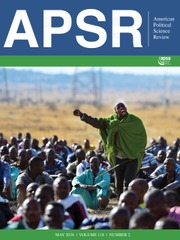Article contents
Candidate Entry and Political Polarization: An Experimental Study
Published online by Cambridge University Press: 13 November 2018
Abstract
We report the results of a laboratory experiment based on a citizen–candidate model with private information about ideal points. Inefficient political polarization is observed in all treatments; that is, citizens with extreme ideal points enter as candidates more often than moderate citizens. Second, less entry occurs, with even greater polarization, when voters have directional information about candidates’ ideal points, using ideological party labels. Nonetheless, this directional information is welfare enhancing because the inefficiency from greater polarization is outweighed by lower entry expenses and better voter information. Third, entry rates are decreasing in group size and the entry cost. These findings are all implied by properties of the unique symmetric Bayesian equilibrium cutpoint pair of the entry game. Quantitatively, we observe too little (too much) entry when the theoretical entry rates are high (low). This general pattern of observed biases in entry rates is implied by logit quantal response equilibrium.
- Type
- Research Article
- Information
- Copyright
- Copyright © American Political Science Association 2018
Footnotes
We thank participants at the Public Policy and Social & Economic Behavior Conference, Cologne; 1st Southwest Experimental and Behavioral Economics Conference, UC Irvine; North-American ESA meeting, Tucson; Venice Political Economy Conference; 7th Social Dilemmas Meeting, UMass; Behavioral Models of Politics Conference, Duke; and at seminars at Beijing Normal, Bocconi, Caltech, Columbia, USC, and UQAM for their helpful comments. Großer acknowledges support from the CEC-COFRS Award, Florida State University. Palfrey acknowledges support from NSF (SES-1426560), the Gordon and Betty Moore Foundation (SES-1158), and a Russell Sage Foundation Visiting Scholar Fellowship (2014–15). Replication materials can be found on Dataverse at: https://doi.org/10.7910/DVN/EDRAIQ.
References
REFERENCES
- 7
- Cited by



Comments
No Comments have been published for this article.